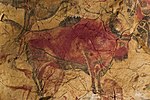National Museum and Research Center of Altamira

The National Museum and Research Center of Altamira (Spanish: Museo Nacional y Centro de Investigación de Altamira), also known as Altamira Museum (Spanish: Museo de Altamira), is a center dedicated to the conservation of, research into and the sharing of information about the cave of Altamira in Santillana del Mar (Cantabria, Spain), named a World Heritage Site by Unesco. The museum offers prehistoric technology workshops to visitors, as well as a permanent exhibition called Times of Altamira, which contains objects from Altamira as well as those from other palaeolithic caves of Cantabria such as El Morín, El Juyo and El Rascaño. The New Altamira Cave, or Neocave, is also part of this exhibition: an artificial replica of the original caves, built in order to preserve the originals from damage arising from a massive influx of visitors.
Excerpt from the Wikipedia article National Museum and Research Center of Altamira (License: CC BY-SA 3.0, Authors, Images).National Museum and Research Center of Altamira
Acceso a las Cuevas de Altamira,
Geographical coordinates (GPS) Address Phone number Website External links Nearby Places Show on map
Geographical coordinates (GPS)
| Latitude | Longitude |
|---|---|
| N 43.3774 ° | E -4.1225 ° |
Address
Museo Nacional y Centro de Investigación de Altamira (Museo de Altamira)
Acceso a las Cuevas de Altamira
39330
Cantabria, Spain
Open on Google Maps








